Download
Harmless

Posts: 22
Registered: 29-1-2018
Member Is Offline
Mood: No Mood
|
|
What is this sludge in my perchlorate cell?
I'm on my second run of my perchlorate cell. I load it up with 3.5L of saturated NaCl solution and add HCl daily to it to keep the pH between 6 and 7.
Slowly a brown lightweight sludge forms. It does not settle well. Last time around I ignored it and filtered it off at the end (took two days to
filter it though filter paper). Today, about half-way through a run, I saw the current had dropped by about half. I disconnected everything and gave
all the terminals a good scrub with a wire brush to remove oxides, reassembled, and saw very little improvement.
I'm not sure if the sludge is the culprit or no, but i decided to run the whole thing though my new filter funnel. It took one 250ml scoop of solution
to get it clogged up despite a good vacuum.
I gave up, rinsed it out and found the glass frit felt slimy, so I ran HCl and then 35% HNO3 through it which did not get rid of the slimyness. The
small amount of sludge I scooped out was dried and I tried burning some which didn't do anything making me believe it's not a chlorate or perchlorate.
I thought it might be an iron compounding going by the colour.
I believe it's a polymer of some sort. My best guess is it's some sort of stabiliser added to the HCl. I heard from Explosions&Fire that here in
Australia HCl contains some sort of iron compound for some reason which would fit the colour seen. Perhaps something that has reacted with Cl, ClO2
etc.
Any ideas?
|
|
|
mysteriusbhoice
Hazard to Others
  
Posts: 477
Registered: 27-1-2016
Member Is Offline
Mood: Became chemistry catboy Vtuber Nyaa
|
|
iron can kill some MMO btw if thats what you were using to convert NaCl into chlorate.
Shoulda added CaCl2 to protect your electrodes from F2 and Fe and all nasties aswell as control the pH.
Fuck HCl pH control its dated!! CaCl2 is the best its automatic and passive just gotta do calculation based of acid consumption rate on that 1 paper.
anyway for perchlorate itself you dont even need pH control on it.
Brown sludge is most likely some ferrous silicate complex or if you used PbO2 in a chlorate cell then its PbO2 nanoparticles.
[Edited on 6-12-2020 by mysteriusbhoice]
|
|
|
yobbo II
National Hazard
   
Posts: 777
Registered: 28-3-2016
Member Is Offline
Mood: No Mood
|
|
You have a chlorate cell not a perchlorate cell.
mmo will not make perk. in any sensible fashion.
|
|
|
mysteriusbhoice
Hazard to Others
  
Posts: 477
Registered: 27-1-2016
Member Is Offline
Mood: Became chemistry catboy Vtuber Nyaa
|
|
best to specify what electrodes he is using because at this point it just looks like a chlorate cell.
|
|
|
Download
Harmless

Posts: 22
Registered: 29-1-2018
Member Is Offline
Mood: No Mood
|
|
Quote: Originally posted by mysteriusbhoice  | iron can kill some MMO btw if thats what you were using to convert NaCl into chlorate.
Shoulda added CaCl2 to protect your electrodes from F2 and Fe and all nasties aswell as control the pH.
Fuck HCl pH control its dated!! CaCl2 is the best its automatic and passive just gotta do calculation based of acid consumption rate on that 1 paper.
anyway for perchlorate itself you dont even need pH control on it.
Brown sludge is most likely some ferrous silicate complex or if you used PbO2 in a chlorate cell then its PbO2 nanoparticles.
[Edited on 6-12-2020 by mysteriusbhoice] |
While you don't "need" pH control, it does improve efficiency by a not inconsiderable amount and means for $1 of acid I can cut a week off my cell
runtime.
It's not PbO2 either. There's way too much of it. My anode would have completely vanished if it was. In fact, there's basically no wear on my anode.
Not sure where fluorine would come from given I haven't added any.
I don't recall mentioning MMO anywhere.
It's PbO2 for the record. I'm not sure what else people are using for perchlorate given it wrecks even Pt anodes.
|
|
|
mysteriusbhoice
Hazard to Others
  
Posts: 477
Registered: 27-1-2016
Member Is Offline
Mood: Became chemistry catboy Vtuber Nyaa
|
|
Then if current went low you probably don't have your buss bars or contacts copper plated
PbO2 doesn't like NaCl feed and will errode slightly producing PbO2 nanoparticles that give strong brown colour and they also form this weird cloudy
mess with other impurities in the salt
Overall heres an example of my cell where im running pure recrystalized Chlorate only and it doesnt have brown or any sludge.
Electrodes are epoxy composite substrate PbO2 plated over with lead perchlorate so it can etch the polymer in areas and build a highly conductive
B-PbO2 layer.
PbO2 doesnt like Chlorides in the cell and though it can tank them it will errode slightly until a Pb2+ ion equilibrium with chloride is reached
leading to stoppage of errosion but an everpresent brown sludge.
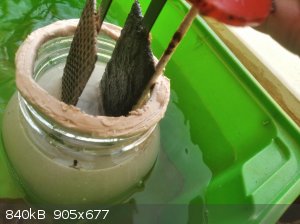 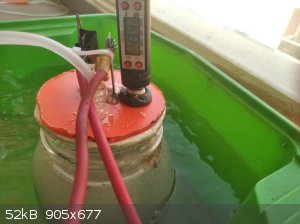
Last pic is of copper plated buss bars which is a must for high current electrolysis.
[Edited on 7-12-2020 by mysteriusbhoice]
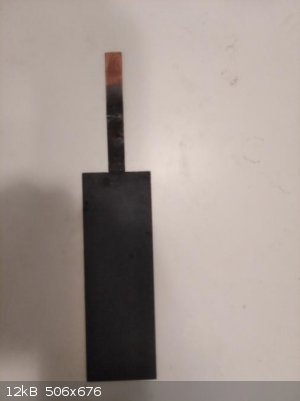
Lastly on pH control it only works well when you run past 60 Celsius! and also dont bother using HCl since its not steady!! use CaCl2 which is the
better solution for automatic pH control at 6.8 via hydroxide precipitation onto cathode and bottom.
you cant just run NaCl on PbO2 worst is you added HCl which reacts with PbO2 rapidly especially when in a hot solution.
It will only take off a little but its still going to be noticeable since it will form a colloidal suspension.
[Edited on 7-12-2020 by mysteriusbhoice]
|
|
|
yobbo II
National Hazard
   
Posts: 777
Registered: 28-3-2016
Member Is Offline
Mood: No Mood
|
|
Sorry about that.
A very small amount of some impurityor other in a cell can look like a lot of material sometimes. It can get 'fluffed' up and if taken out (the
impurity that is) dried and weighed it can be a surprisingly small amount of stuff.
Solid platinum anodes hold up well enough even if there is some chloride around. It's best to have pure chlorate in a perk. cell though. LD does not
last for ever either.
You can remove Ca by adding a sulphate or carbonate (carbonate is probabley best) at the end. I have heard of Calcium being blamed for pyro. mishaps
somewhere or other.
Yob
|
|
|
mysteriusbhoice
Hazard to Others
  
Posts: 477
Registered: 27-1-2016
Member Is Offline
Mood: Became chemistry catboy Vtuber Nyaa
|
|
Quote: Originally posted by yobbo II  |
Sorry about that.
A very small amount of some impurityor other in a cell can look like a lot of material sometimes. It can get 'fluffed' up and if taken out (the
impurity that is) dried and weighed it can be a surprisingly small amount of stuff.
Solid platinum anodes hold up well enough even if there is some chloride around. It's best to have pure chlorate in a perk. cell though. LD does not
last for ever either.
You can remove Ca by adding a sulphate or carbonate (carbonate is probabley best) at the end. I have heard of Calcium being blamed for pyro. mishaps
somewhere or other.
Yob |
IF your LD anode is getting thin you can just save some NaClO4 and crank out your ion exchange electrolysis cell with lead anode and create a plating
solution that goes into a membrane cell and your electrode can easily be re coated!
my perchlorate run btw is going well with my homemade epoxy PbO2 composite substrate PbO2 electrode at 170ma/cm^2.
positive test and day 3 cell appearance
yea it could be just impurities in the salt Ferrous silicate and exacerbated with your dirty HCl
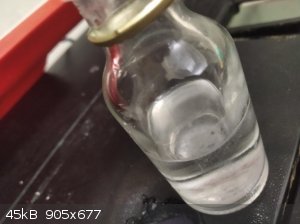 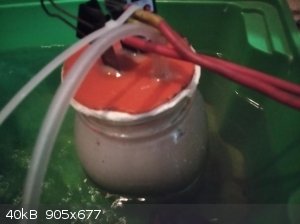
[Edited on 8-12-2020 by mysteriusbhoice]
|
|
|
mysteriusbhoice
Hazard to Others
  
Posts: 477
Registered: 27-1-2016
Member Is Offline
Mood: Became chemistry catboy Vtuber Nyaa
|
|
Quote: Originally posted by Download  | I'm on my second run of my perchlorate cell. I load it up with 3.5L of saturated NaCl solution and add HCl daily to it to keep the pH between 6 and 7.
Slowly a brown lightweight sludge forms. It does not settle well. Last time around I ignored it and filtered it off at the end (took two days to
filter it though filter paper). Today, about half-way through a run, I saw the current had dropped by about half. I disconnected everything and gave
all the terminals a good scrub with a wire brush to remove oxides, reassembled, and saw very little improvement.
I'm not sure if the sludge is the culprit or no, but i decided to run the whole thing though my new filter funnel. It took one 250ml scoop of solution
to get it clogged up despite a good vacuum.
I gave up, rinsed it out and found the glass frit felt slimy, so I ran HCl and then 35% HNO3 through it which did not get rid of the slimyness. The
small amount of sludge I scooped out was dried and I tried burning some which didn't do anything making me believe it's not a chlorate or perchlorate.
I thought it might be an iron compounding going by the colour.
I believe it's a polymer of some sort. My best guess is it's some sort of stabiliser added to the HCl. I heard from Explosions&Fire that here in
Australia HCl contains some sort of iron compound for some reason which would fit the colour seen. Perhaps something that has reacted with Cl, ClO2
etc.
Any ideas? |
I got a similar precipitate in my cell after 100% conversion into perchlorate from fresh chlorate feed 600g. ran for 4 days at 170 and later
200ma/cm^2
edit:
NVM its not 100% conversion because it still turns yellow when heated strongly with HCl but its quite a lot of conversion
This brown thing I got is most likely PbO2 attached to some organic polymer probably from my electrode themselves since its a polymer composite
electrode
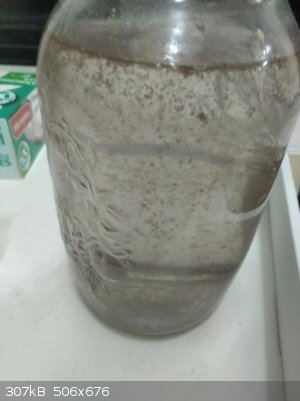
[Edited on 8-12-2020 by mysteriusbhoice]
[Edited on 8-12-2020 by mysteriusbhoice]
|
|
|
yobbo II
National Hazard
   
Posts: 777
Registered: 28-3-2016
Member Is Offline
Mood: No Mood
|
|
Why do Calcium chlorate cells not need pH control?
Some chlorine must be escaping just like a sodium cell.
Yob
|
|
|
macckone
Dispenser of practical lab wisdom
    
Posts: 2171
Registered: 1-3-2013
Location: Over a mile high
Member Is Offline
Mood: Electrical
|
|
yobbo,
because the hydroxide and carbonate precipitates and CO2 is absorbed providing the 'acid'.
You wouldn't run straight CaCl2, but use it as an additive.
I haven't heard of calcium being blamed but ammonium chlorate is unstable and any chlorate with sulfur is unstable.
Perchlorate with sulfur isn't exactly recommended either.
The mechanism for sulfur instability is pretty straight forward.
The sulfur is oxidized to acid which of course releases chloric or perchloric acid.
Both of which are not particularly stable and rapidly react with sulfur.
|
|
|
yobbo II
National Hazard
   
Posts: 777
Registered: 28-3-2016
Member Is Offline
Mood: No Mood
|
|
Do you mean that CO2 is absorbed from the atmosphere?
Working with a sealed cell ie. a cell with just a pipe to the atmosphere you would not get much CO2.
Long time ago someone or other suggested bubbling in CO2 to a cell to control the pH but I am not aware of anyone acutally trying it out.
If calcium chlorate --> perchlorate can be made (by running straight CaCl2) it woud provide a great route to ammonium perchlorate.
Just add ammonium sulphate (to the purified solution of Ca perk.) and you get insoluble calcium sulphate and ammonium perk. in solution.
Yob
[Edited on 29-1-2021 by yobbo II]
|
|
|